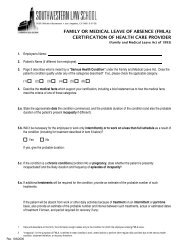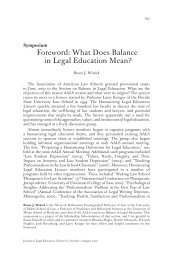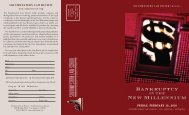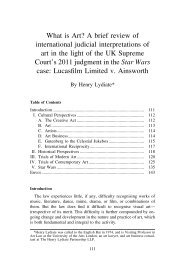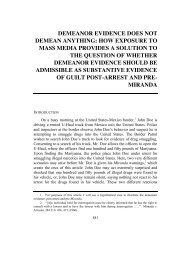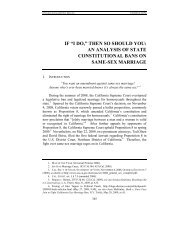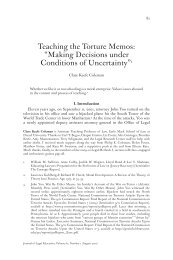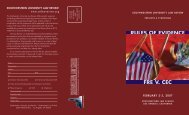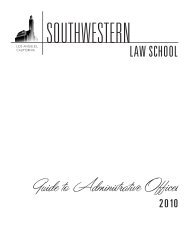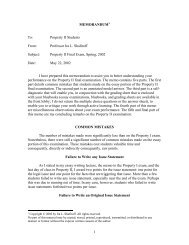An Autobiography of a Digital Idea - Southwestern Law School
An Autobiography of a Digital Idea - Southwestern Law School
An Autobiography of a Digital Idea - Southwestern Law School
You also want an ePaper? Increase the reach of your titles
YUMPU automatically turns print PDFs into web optimized ePapers that Google loves.
<strong>An</strong> <strong>Autobiography</strong> <strong>of</strong> a <strong>Digital</strong> <strong>Idea</strong><br />
489<br />
random access 17 possible and digital students are constantly “surfing the web”<br />
to discover information. 18 As a result, digital students are not passive, waiting<br />
for the author’s next sequential move. Instead, students are the “drivers” <strong>of</strong> the<br />
information-gathering process, navigating their way through multiple layers<br />
<strong>of</strong> text on the screen. 19 The students like to be in control <strong>of</strong> “what, when, and<br />
how they learn.” 20 “They ‘accept as their right’ the ability to make choices and<br />
to customize the things they choose.” 21 They think <strong>of</strong> learning as a process <strong>of</strong><br />
discovery. 22<br />
B. Multitasking and Telescoping<br />
Second, digital students research by multitasking 23 and “telescoping.” 24<br />
In multi-tasking, a student performs many acts at one time such as reading<br />
e-mail, taking notes during lecture, playing poker, and listening to music. 25<br />
In telescoping, a student delves deeper and deeper into multiple screens and<br />
varied content seamlessly. 26 These students can probe deeper and deeper into<br />
content nestled within other content (in this context, screens nestled within<br />
other screens) while maintaining an understanding <strong>of</strong> the relationship between<br />
the screens. To pr<strong>of</strong>essors, all these screens and layers might seem chaotic. But<br />
“telescoping is all about order, not chaos; it’s about constructing the proper<br />
hierarchy <strong>of</strong> tasks and moving through the tasks in the correct sequence. It’s<br />
about perceiving relationships and determining priorities.” 27 <strong>Digital</strong> students<br />
are facile at it. Their ability to move in and out, with multiple screens open<br />
(while listening to their iPods and IM-ing each other), is a testimony to their<br />
capacity to learn from multiple sources all at the same time.<br />
17. M. Ethan Katsh, <strong>Law</strong> in a <strong>Digital</strong> World 166 (Oxford Univ. Press 1995). For more information<br />
on hyperlinks see David R. Johnson, Building and Using Hypertext Systems, 17 <strong>Law</strong> Prac.<br />
Mgmt. 28, 29 (1991).<br />
18. Theodor Nelson, who coined the term, defined “hypertext” as “non-sequential writing‐text<br />
that branches and allows choices to the reader.” Katsh, supra note 17, at 166.<br />
19. Carlson, supra note 5, at 7.<br />
20. Id.<br />
21. Id.<br />
22. Donahoe, supra note 15.<br />
23. <strong>An</strong>gela Provitera McGlynn, Teaching Millenials, Our Newest Cultural Cohort, 71 The<br />
Educ. Digest 4, 15 (2005) (“Multitasking is a way <strong>of</strong> life for this generation.”); Carlson, supra<br />
note 19.<br />
24. Steven Johanson, Everything Bad Is Good For You—How Today’s Popular Culture Is<br />
Actually Making Us Smarter 54 (Riverhead 2005).<br />
25. McGlynn, supra note 23 (“These students believe they can learn complex information while<br />
listening to music or engaging in other activities.”).<br />
26. Johanson, supra note 24.<br />
27. Id. at 55.



